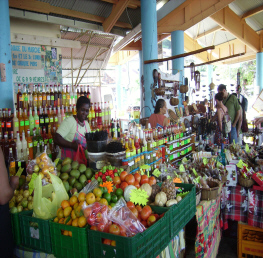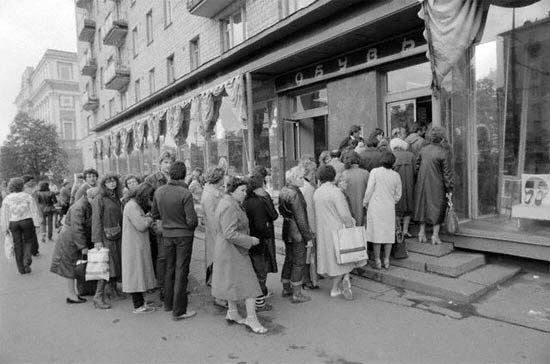|
|
|
|
|
|
1.
|
Study the information above.
Explain what you expect to learn from this unit. Pay attention to the vocabulary words as you will be
tested on them later on.
|
|
|
In
Section 1, you read how supply and
demand interact to determine the equilibrium
price and
quantity sold in a market.
You also read about how those prices
change over time. Prices are a
key element
of equilibrium. Price changes can move
markets toward equilibrium and
solve
problems of excess supply and excess
demand. In this section we will discuss
the
importance of prices and the role they play.
| In a free market, prices are a tool
for
distributing goods and resources
throughout the economy. Prices are nearly
always the
most efficient way to allocate,
or distribute, resources. The alternative
method for
distributing goods and
resources, namely a centrally planned
economy, is not nearly as
efficient as a
market system based on prices.
| | |
|
|
|
2.
|
Which statement below is
true?
a. | Prices are not important when
constructing a business model | c. | Prices cannot move markets toward
equilibrium | b. | Usually the market ignores prices | d. | Prices can move markets toward
equilibrium |
|
|
|
3.
|
Which statement below is
true?
a. | In a centrally planned economy price
is an important factor | c. | Since Communism
believes that everything should be shared by evenly, price is an important factor in making the
economy fair to everyone | b. | Free market economies usually ignore price as a factor in the business
model | d. | In a free market economy price is a very important factor
in supply and demand |
|
|
|
Prices in
the Free Market
Prices
serve a vital role in a free market economy. Prices help move land, labor, and capital into the hands
of producers, and
finished goods into the hands of buyers. The following example shows the
benefits of a system based on free market prices.
Kevin decides to buy a sweater for his
sister for her birthday next month. He goes to a nearby shopping center and compares the prices of
several different sweaters. Kevin finds that a department store offers cotton cable-knit sweaters for
$30 to $50 and soft cashmere sweaters for $110. He visits other stores and finds that he can spend as
little as $20 for an acrylic sweater or as much as $350 for a designer cashmere sweater. Kevin
considers his sister’s tastes and his own income and buys his sister one of the less expensive
cotton sweaters.
Later, Kevin uses his computer to browse catalogs of mail-order stores.
He’s surprised to find a sweater very similar to the one he bought, but it’s on sale for
$5 less, shipping included. Kevin decides to buy the sweater on-line with his credit card and return
the sweater he bought at the mall.
|
Kevin’s story, familiar to anyone who has
shopped for a gift, demonstrates the importance of prices to the free market system. The simple
process of buying a gift for a friend or relative would be much more complicated and inefficient
without the price system.
 | | |
|
|
|
4.
|
Which statements are true?
(pick all that apply)
|
|
|
5.
|
Which statements below are true
for Kevin? (pick all that apply)
|
|
|
The
Advantages of Prices
Prices provide a language for buyers and sellers. Could you conceive of a marketplace
without prices? Without prices as a standard measure of value, a seller would have to barter for
goods by bidding shoes or apples to purchase a sweater. A sweater might be worth two pairs of shoes
to one customer, but another customer might be willing to trade three pairs of shoes for the same
sweater. The supplier would have no consistent and accurate way to measure demand for a
product. | Price as an
Incentive
Buyers and
sellers alike look at prices to
find information on a good’s demand and
supply. The law
of supply and the law of demand describe how people and firms
respond to a change in prices. In
these
cases, prices are a signal that tell a
consumer or producer how to adjust.
Prices
communicate to both buyers and sellers
whether goods are in short supply or
readily
available.
In the example of the popular doll
discussed in Section 2, the
increased
demand for the doll told suppliers that
people wanted more dolls, and
soon!
However, the signal that producers respond
to is not simply the demand, but the
high
price consumers are willing to pay for the
doll, well above the usual retail price.
This
higher price tells firms that people want
more dolls, but also that the firms can
earn
more profit by producing more dolls,
because they are in demand. Therefore,
rising
prices in a market will cause existing
firms to produce more goods and will
attract new firms
to enter a market. | Prices as Signals
Think of prices as a traffic light. A relatively
high
price is a green light that tells
producers that a specific good is in demand
and that they
should use their resources to
produce more. New suppliers will also join
the market. A low
price, however, is a red
light to producers that a good is being
overproduced. In this case,
low prices tell a
supplier that he or she might earn higher
profits by using existing resources
to
produce a different product.
For consumers, a low price is a green
light to buy more
of a good. A low price
indicates that the good carries a low opportunity cost for the consumer,
and offers a
good buying opportunity. By the same
token, a high price is a red light to stop
and
think carefully before buying.
| | |
|
|
|
6.
|
Which statement is
true?
a. | Price is the language of the market
place | c. | Price has little effect on market
equilibrium | b. | Price effects supply more than demand | d. | Once set, the price of a product rarely
changes |
|
|
|
7.
|
Which statements are true?
(pick all that apply)
|
|
|
8.
|
Price communicates information
to
a. | buyers and
sellers | c. | sellers more than
buyers | b. | buyers but not sellers | d. | buyers more than sellers |
|
|
|
Flexibility
Another important aspect of prices is that
they are flexible. When a supply shift or
a
demand shift changes the equilibrium in a
market, price and quantity supplied need
to
change to solve problems of too much or
too little demand. In many markets, prices
are
much more flexible than output levels.
Prices can be easily increased to solve a
problem of
excess demand, and they can
be just as easily decreased to eliminate a
problem of excess
supply.
For example, a supply shock is a sudden
shortage of a good, such as gasoline
or
wheat. A supply shock creates a problem of
excess demand because suppliers can no
longer
meet the needs of consumers. The
immediate problem is how to divide up the
available supply
among consumers.
What are the options? Increasing supply
can be a time-consuming and
difficult
process. For example, wheat takes time to
plant, grow, and harvest. Rationing,
or
dividing up goods and services using
criteria other than price, is expensive and
can
take a long time to organize. Rationing
is the basis of central planning, which you
read about
in Chapter 2.
Raising prices is the quickest way to
resolve excess demand. A quick rise in
prices
will reduce quantity demanded to the same
level as quantity supplied and avoid
the
problem of distribution. The people who
have enough money and value the good
most highly
will pay the most for the good.
These consumers will be the only consumers
still in the market
at the higher price, and
the market will settle at a new equilibrium. | Price System Is “Free”
Unlike central planning, a distribution
system based on
prices costs nothing to
administer. Central planning requires
central planners who collect
information
on production and decide how resources
are to be distributed. In the former
Soviet
Union, the government employed thousands
of bureaucrats in an enormous
agency called
GOSPLAN to organize the
economy. During World War II, the United
States government set up the
Office of Price
Administration to prevent inflation and
coordinate rationing of important
goods.
On the other hand, free market pricing
distributes goods through millions of
decisions
made daily by consumers and
suppliers. Kevin, from the beginning of the
section,
looks at the prices of sweaters and
decides which one to buy for his sister and which supplier to
buy it from. A farmer
reads the reports from the commodity
exchanges and decides whether to
grow
corn instead of soybeans next year.
Everyone is familiar with how prices work
and knows
how to use them. In short,
prices help goods flow through the
economy without a central
plan.
 | | |
|
|
|
9.
|
Why are prices
flexible?
a. | Because a change in price usually
indicates a serious flaw in the market | c. | They can easily increase or decrease to meet the demands of the
market | b. | Once set they cannot easily be changed | d. | They can increase but not decrease in meeting the demands of the
market |
|
|
|
10.
|
What is a supply shock?
a. | a gradual increase in
supply | c. | a gradual shortage of a
good | b. | a sudden shortage of a good | d. | a sudden increase in supply |
|
|
|
11.
|
Supply shocks create a problem
of
a. | a new
equilibrium | c. | excess
demand | b. | to little demand | d. | excess supply |
|
|
|
12.
|
What is the quickest way to
resolve the problem of too much demand.
a. | Price
manipulation | c. | Production
expansion | b. | Supply manipulation | d. | Production contraction |
|
|
|
13.
|
How would a central planning
socialist go about solving the problem of excess demand?
a. | shoot the consumers until demand
fell to normal ranges | c. | price
manipulation | b. | rationing | d. | decreasing supply |
|
|
|
14.
|
What is the least expensive method of product
distribution?
a. | free market
pricing | c. | rationing | b. | central planning | d. | increasing supply |
|
|
|
A Wide
Choice of Goods
One of
the benefits of a market-based
economy is the diversity of goods and
services consumers can
buy. Price gives
suppliers a way to allow consumers to
choose among similar products.
Kevin
could buy his sister an acrylic sweater for
$20, a cotton sweater for $40, or
a
cashmere sweater for much more. Based on
his income and his sister’s tastes,
Kevin
decided on a cotton sweater at the lower
end of the price range. The prices
provided
an easy way for Kevin to narrow his
choices to a certain price range. Prices
also
allow producers to target the audience they
want with the products that will sell best
to
that audience.
In a command economy, however, one
organization decides what goods
are
produced and how much stores will charge
for these goods. To limit their
costs, | central planners restrict production to a
few varieties of each product. As
a result,
consumers in the former Communist states
of Eastern Europe and the Soviet
Union
had far fewer choices of goods than
consumers in Western Europe and the
United States.
You may ask why
Communist governments used a command
economic system. The answer is, in
part,
that they hoped to distribute wealth evenly
throughout their society. As a result,
the
government of the Soviet Union built whole
neighborhoods of identical apartment
blocks
and supermarkets with names such
as “Supermarket No. 3.”
 | | |
|
|
|
15.
|
In which type of economy are
you likely to have the widest variety of goods and services?
a. | command
economy | c. | free market
capitalism | b. | central planning economy | d. | socialism |
|
|
|
16.
|
Why did the Soviet Union choose
a command economy?
a. | they were striving for equality in
all things | c. | they like to give
orders | b. | they wanted to keep the population poor so they could control
them | d. | it works better than free market
capitalism |
|
|
|
 | Rationing and
Shortages
Although goods
in the Soviet Union were inexpensive, consumers could not always find them. When they did, they often
had to wait hours for eggs or soap, years for apartments or telephones. The United States experienced
similar problems, although far less severe, when the government instituted temporary price controls
during World War II.
Although rationing in the United States was only a short-term hardship,
like rationing in the Soviet Union it was expensive and left many consumers unhappy. The needs of the
U.S. armed forces for food, metal, and rubber during World War II created tremendous shortages at
home, | and the government controlled the
distribution of food and consumer goods. Choices were limited, and consumers felt, rightly or
wrongly, that some people fared better than others. However, rationing was chosen because a
price-based system might have put food and housing out of the reach of some Americans, and the
government wanted to guarantee every civilian a minimum standard of living in
wartime. | | |
|
|
|
17.
|
In which system were prices for
goods and services lower?
a. | Soviet command
economy | c. | Hollywood
California | b. | free market capitalism | d. | La Jolla California |
|
|
|
18.
|
Why did the government
institute rationing during World War II?
a. | they wanted to increase the supply
of consumer goods | c. | they wanted to
eliminate the black market | b. | they wanted to create a bad economy and blame it on the
Republicans | d. | they wanted to make sure goods and
services were distributed evenly throughout the economy |
|
|
|
The Black
Market
Despite the
ration system, the
federal government was unable to control
the supply of all goods passing
through the
economy. A butcher could sell a steak
without asking for ration points, or
a
landlord might be willing to rent an apartment
at the rate fixed by the government
only if
the renter threw in a cash “bonus”
or an extra two months’ rent as
a
“deposit.”
| When people conduct business without
regard for
government controls on price or
quantity, they are said to do business on
the
black market. Black markets
allow
consumers to pay more so they can buy a
good when rationing makes it
otherwise
unavailable. Although black markets are a
nearly inevitable consequence of
rationing,
such trade is illegal and strongly discouraged
by
governments. | | |
|
|
|
19.
|
Which statement is
true?
a. | there was not black market during
WWII | c. | the government was unable to control
the black market during WWII because they could not control each and every
supplier | b. | the government was unable to control the black market during WWII because of
rationing | d. | the government was able to control
the black market using rationing |
|
|
|
20.
|
What is a black
market?
a. | People ignoring government controls
over the economy | c. | Central planners
attempting to control the market | b. | People using rationing to control the market | d. | The black market is the same as the white
market |
|
|
|
Efficient
Resource Allocation
All
of the advantages of a free market
allow prices to allocate resources efficiently.
Efficient
resource allocation means
that economic resources—land, labor, and
capital—will be
used for their most
valuable purposes. A market system, with
its freely changing prices,
ensures that
resources go to the uses that consumers
value most highly. A price-based
system
also ensures that resource use will adjust
to the changing demands of
consumers.
| These changes take place without any
central control, because the people
who
own resources—landowners, workers who
sell their labor, and people who
provide
capital to firms—seek the largest possible
returns. How do people earn the
largest
returns? By selling their resources to the
highest bidder. The highest bidder will
be
that firm that produces goods that are in
the highest demand. Therefore, the
resources
will flow to the uses that are most
highly valued by consumers. This flow is
the most efficient
way to use our society’s
scarce resources. | | |
|
|
|
21.
|
What are the advantages of a
price based system? (pick all that apply)
|
|
|
Prices and
the Profit Incentive
Suppose that scientists predicted extremely hot weather for the coming summer. In most
parts of the country, consumers would buy up air conditioners and fans, to prepare for the heat.
Power companies would buy reserves of oil and natural gas to supply these appliances with enough
power. Since demand would exceed supply, consumers would bid up the price of fans, and power plants
would bid up the price of fuel. Suppliers would recognize the possibility for profit in the higher
prices charged for these goods, and they would produce more fans and air conditioners. Oil and
natural gas fields would hire workers to pump more fuel for power plants. Eventually, more fans, air
conditioners, and fuel would move into the market. The potential heat wave would have created a need
for certain goods, and the rise in prices would have given producers an incentive to meet this
need.
| As we previously noted, efficient resource allocation occurs naturally in a
market system as long as the system works reasonably well. Landowners tend to use their scarce
property in the most profitable manner. Workers usually move toward high-paying jobs, and capital
will be invested in the firms that pay the highest returns. | | |
|
|
|
22.
|
What is the motivating force in
the narrative above?
a. | a desire to distribute resources
fairly | c. | a desire to help the
poor | b. | a desire to increase profits | d. | a desire to help the environment but selling more fans and less fuel
oil |
|
|
|
23.
|
Which groups in the narrative
above are seeking an advantage and greater profits (pick all that apply)
|
|
|
The
Wealth of Nations
Adam Smith made this point in his famous
book The Wealth of Nations,
published in
1776. Smith explained that it was not
because of charity that the baker and
the
butcher provided people with their food.
Rather, they provide people with bread
and meat
because prices are such that they
will profit from doing so. In other words,
businesses prosper
by finding out what
people want, and then providing it. This
has proved to be a more efficient
system
than any other that has been tried in the
modern era. |
 | | |
|
|
|
24.
|
What did Adam Smith say
motivated business people to provide goods and services to the public?
a. | low prices which increased
demand | c. | low prices which made profits
possible | b. | a concern for the welfare of mankind | d. | high prices which make profits
possible |
|
|
|
Market
Problems
There are some
exceptions to the general
idea that markets lead to an efficient allocation
of resources. The
first problem, imperfect
competition, can affect prices, and
higher prices can affect consumer
decisions.
If only a few firms are selling a product,
there might not be enough
competition
among sellers to lower the market price
down to the cost of production. When
only
one producer sells a good, this producer
will usually charge a higher price than
we
would see in a market with several competitive
businesses. In the following chapter,
you
will read more about how markets
behave under conditions of
imperfect
competition.
.
|
A second problem can involve spillover
costs, also known as externalities,
that
include costs of production, such as air
and water pollution, that “spill
over” onto
people who have no control over how
much of a good is produced.
Since
producers do not have to pay spillover
costs, their total costs seem artificially
low,
and they will produce more than the equilibrium quantity of the good. The extra
costs will
be paid by consumers
Imperfect information is a third problem
that can prevent a market
from operating
smoothly. If buyers and sellers do not have
enough information to make
informed
choices about a product, they may not
make the choice that is best for
them.
| | |
|
|
|
25.
|
Because there is only one
utility company in San Diego (SDGE), Adam Smith would say that this is an example
of
a. | free market
capitalism | c. | imperfect
competition | b. | efficient utilization of resources | d. | perfect competition |
|
|
|
26.
|
What is the problem with
“Spillover Costs?”
a. | they make the price of goods and
services higher than they should be | c. | there is no problem with Spillover costs | b. | they result in the costs being paid by the
producers | d. | they make the price seem lower than
it actually is causing consumers to pay for the hidden
costs |
|
|
|
27.
|
Which company below is most
responsive to price and market forces?
a. | SDGE | c. | Walmart | b. | Otay Water | d. | The School System |
|
|
|
a. | shortage | e. | surplus | b. | spillover costs | f. | black market | c. | search costs | g. | supply shock | d. | rationing |
|
|
|
28.
|
a system of allocating scarce
goods and services using criteria other than price
|
|
|
29.
|
a market in which goods are
sold illegally
|
|
|
30.
|
situation in which quantity
supplied is greater than quantity demanded; also known as excess supply
|
|
|
31.
|
a sudden shortage of a
good
|
|
|
32.
|
costs of production that
affect people who have no control over how much of a good is produced
|
|
|
33.
|
situation in which quantity
demanded is greater than quantity supplied; also known as excess demand
|
|
|
34.
|
the financial and opportunity
costs consumers pay when searching for a good or service
|